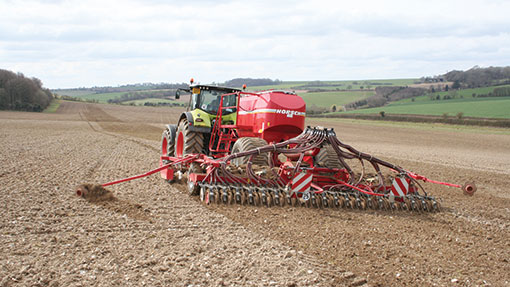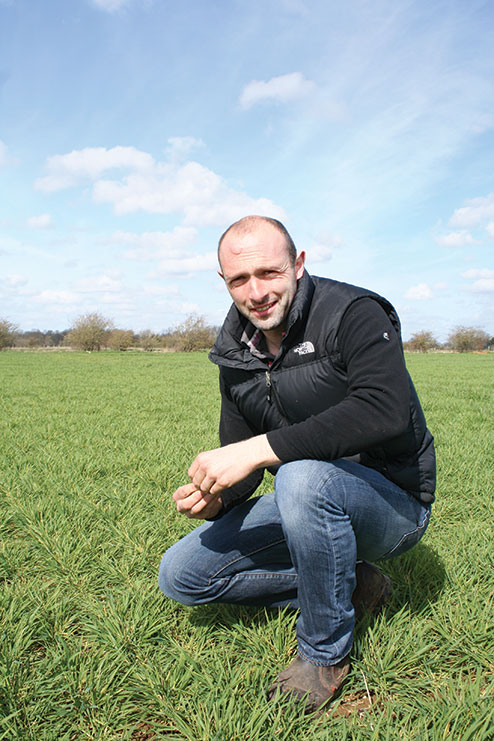Tillage-Live host farm revamps machinery fleet

The tractor and implement fleet at Down Ampney Estate has evolved since it last hosted Tillage-Live five years ago. Peter Hill reports.
Regular visitors to the annual Tillage-Live event may well have driven through the gates of the Down Ampney Estate in 2009 when Farmcare last hosted the cultivations and drilling extravaganza.
Some things are much the same, including the presence of manager James Taylor. But others have changed. The operation is now under new ownership following the acquisition of the Co-Op Group’s farming interests by the Wellcome Trust, a lot more land is under Mr Taylor’s stewardship and the tractor and implement fleet have been overhauled.
“In 2009, we were farming arable crops across 2,100ha of estate and tenanted or contract-farmed land but that has since increased by 25% to 2,630ha,” he says. “The rotation has also changed to include barley – so now we have winter wheat – winter barley – oilseed rape – winter wheat – spring beans, winter wheat – winter barley, and so on.”
The biggest tractor in 2009 was a sizeable 360hp John Deere 8530, with a 295hp 8520T mostly handling the drilling operations. Remaining cultivation tasks were looked after by a trio of 160hp tractors – a John Deere 6920S and two examples of the Claas Ares 816 RZ.
Bolstering the fleet
With the increase in land has come the need to bolster the tractor fleet, so for the past five years, during which it amassed 6,000hrs, a 388hp Claas Xerion 3800 Trac has been the primary tractor. That machine so successfully proved the abilities of the stepless-drive, rigid-chassis concept that it has been replaced this year by a substantially bigger tractor – a Xerion 5000 Trac with 524hp on tap.
Next up is a 320hp Axion 920 CMatic and, continuing the increased power theme, a 275/290hp John Deere 7250R AutoPowr has just replaced the farm’s 250hp Axion 840 CMatic. It joins a pair of 180/186hp 6930s that handle rolling, fertiliser spreading, grain haulage and hedge maintenance.
The tractor upgrades have been accompanied by changes to the cultivations and drilling fleet, all of which is intended to improve output and consequent timeliness of operations, says James Taylor.
“Windows of opportunity for getting work done are shrinking with the need to produce stale seed-beds for grassweed control and cope with more volatile weather patterns.”
James Taylor, Tillage-Live host farmer
“Windows of opportunity for getting work done are shrinking with the need to produce stale seed-beds for grassweed control and cope with more volatile weather patterns,” he explains. “Our biggest pressure point is oilseed rape establishment but we also needed to work deeper to maintain soil structure.”
Piggy-back seeder
In 2009, a 5m Väderstad TopDown progressive disc and tine cultivator was the primary tool for busting stubbles, with a piggy-back seeder providing one-pass establishment of oilseed rape. The other one-pass oilseed rape seeding option was a newly-acquired five-leg Simba Flatliner subsoiler with DD packer and band-sowing seeder.
Where prior cultivation was carried out, the farm’s 8m Väderstad Rapid cultivating disc drill sowed oilseed rape before moving on to cereal crops.
Today, all soil preparation for oilseed rape is handled by a 5m Great Plains Simba SL disc-and-tine cultivator working in combination with a 5.5m Simba Unipress.
“After winter barley, stubbles are worked to 10in using the SL’s low-disturbance tines, with volunteers then sprayed off,” explains James Taylor. “We then sow the crop with our Horsch Sprinter tine drill, which is operated with only every third coulter in place to give us 45cm bands.”
After wheat crops, the same cultivations combination is used to create a seed-bed and sow rape at the same time.
“Seed is applied behind the DD roller of the SL cultivator in 45cm bands again and the Unipress then covers it and provides instant consolidation to retain whatever moisture we have,” explains Mr Taylor. “The second seeder unit on the Unipress applies slug pellets or companion plants between the oilseed rape rows.”
More weathering
Wheat seed-beds on heavier land – where penetration is more difficult and more weathering is needed to produce a seed-bed – are created using a 4.2m Gregoire-Besson Discordon.
This heavy disc and tine cultivator loosens stubbles while breaking up any compacted soils beyond seed-bed depth, and is followed by a pass with a 5.5m Cultipress to create a consolidated tilth with good soil-to-straw contact.
On lighter land, the SL and Unipress combination has proven itself capable of doing the job in one pass.
In both cases, stale seed-beds are sprayed off and then moved with an 8m Dalbo Cultimax heavy-duty spring tine cultivator to produce a second stale seed-bed two-to-three weeks before drilling.
The Dalbo implement has also taken over the post-ploughing role, where inversion tillage is needed for overwintering ground destined for spring crops, to rectify rutted ground or bury large volumes of trash, and to tackle fields with the worst blackgrass issues.
Down Ampney’s ploughing resource had just been rationalised at the time of the 2009 Tillage-Live event, with Dowdeswell five-furrow mounted and Kverneland six-furrow semi-mounted ploughs being replaced by a Kuhn five-plus-one semi-mounted implement.
Even emergence
Extra drilling capacity has been bought in by replacing the 8m Väderstad Rapid with a 6m Horsch Pronto AS.
“The Pronto AS drill is excellent on the lighter, less stony ground and provides the most even emergence I have ever seen,” says James Taylor.
“It has a twin hopper so that triple super phosphate or DAP [diammonium phosphate] can be applied down the spout.
“Our Sprinter is used on the stonier soils where penetration using discs can be difficult and where discs often bounce out, resulting in uneven establishment,” he adds.
“We also have a 6m Kverneland Accord Tine Seeder, which is our fire-engine drill for when conditions are really poor.”
Having land up to half an hour’s drive away also influenced drill choice to some extent: “The new Pronto runs on large transport wheels whereas the previous drill ran on its packer tyres, which suffered endless punctures from flints after warming up on a long road run.”


